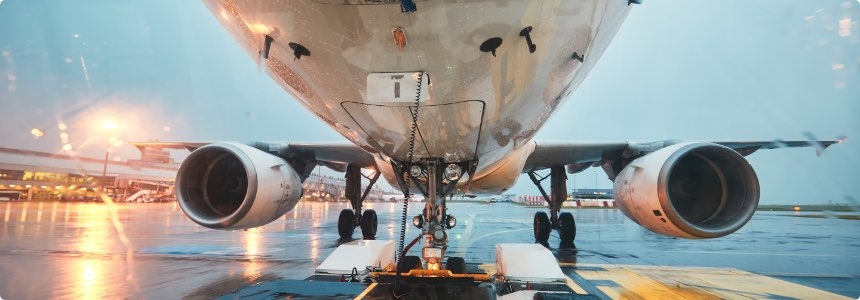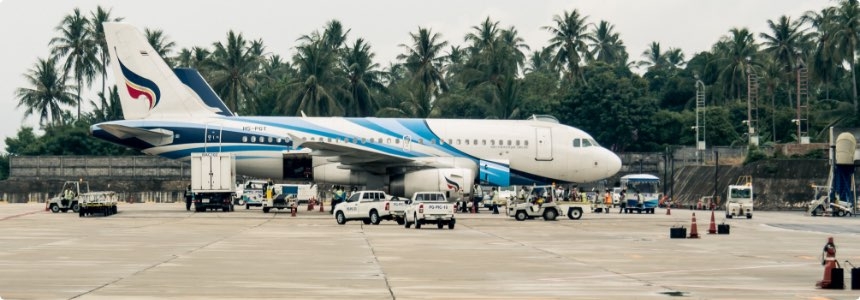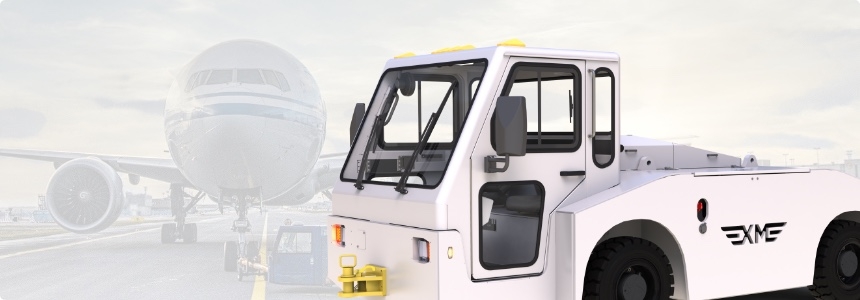1. Utilize the Appropriate Aircraft Tug
The first step in all thorough aircraft towing procedures is ensuring you're using the proper ground support equipment (GSE). Whether you're using aircraft recovery dollies or towbarless tugs, it's important to use the right GSE (with the right towing capacity) for the job. If using towbars, always double-check that you're utilizing the correct towbar and towbar head. Be sure to also inspect the towbar and connection. If there are any cracks, bowing or other visible damage, the towbar should be removed from service immediately.
2. Test the Aircraft Brake System
Before each airport towing operation, the aircraft's brake system must be charged and checked. An aircraft with faulty brakes should only ever be towed into position for brake system repairs. If this is the case, personnel should be standing by with chocks for emergency use. In general, wheel chocks should always be at the ready throughout any aircraft towing operation.
When the aircraft is stopped, never rely upon the brakes of the pushback tug or towing vehicle alone to stop the aircraft. It's important that the person in the flight deck coordinate the use of the aircraft's brakes with those of the GSE.
3. Prepare the Aircraft to be Transported
Before towing the aircraft, it's critical that you verify the engine is completely turned off. And to avoid damage to the aircraft or personal injury during your aircraft towing procedures, make sure that all entrance doors are closed, ladders are fully retracted and gear-down locks are installed. You should also check that all tires and landing gear struts are properly inflated.
4. Ensure Qualified Operators are in Place
It's crucial that all aircraft ground-handling personnel are intimately familiar with each and every procedure pertaining to the various types of aircraft being towed, the GSE fleet and all local operating standards in regard to ground handling procedures. Airline towing is a team effort and requires every member to be on the same page and ready for any situation.
- The aircraft tug operator is responsible for operating the vehicle safely, obeying all instructions given by a fellow team member.
- There will also be wing walkers stationed at each wingtip. This allows the team to provide adequate clearance of any obstruction that may be in the aircraft's path.
- At times, a tail walker may also be assigned in situations where sharp turns may be required or when an aircraft needs to be backed into position.
- A qualified operator will need to sit in the pilot's seat of the aircraft being towed. This allows the aircraft operator to observe and operate the aircraft's parking brake as needed.
- At times, a team member may be stationed to both observe and maintain the pressure of the aircraft's hydraulic system.
5. Operate at a Slow and Steady Speed
When actually towing an aircraft, the towing vehicle must maintain a reasonable speed that does not exceed that of the walking speed of team members. Make sure to never start and stop suddenly. While being towed into position, an aircraft's engines should never be in operation. And for added safety, never apply the aircraft's brakes unless instructed to do so by a team member in an emergency situation.
During transport, the aircraft towing vehicle driver is responsible for controlling the speed and direction of the aircraft. They also will need to obey emergency stop instructions communicated by the other team members in the case of unsafe conditions. This is why the GSE operator must always maintain visual contact with all team members.
6. Park Aircraft Efficiently
For the parking portion of your aircraft towing procedures, you'll need to be smart and precise in order to maximize every square foot of hangar space. You need to be able to fit the maximum number of aircraft into your hangar to maximize efficiency and cost-effectiveness. Understand the space, have the right equipment in place and take it slow. Read our Guide to Aircraft Parking to learn more.
7. Utilize the Proper Parking Equipment
As we've touched on, it's incredibly important to use the right aircraft parking equipment every time you're parking an airplane. This includes wheel chocks, parking boots and airplane covers. In addition to this, ensure your airfield has proper ground signage and lighting. These navigational aids help pilots and ground crews maneuver airplanes around the airport safely and efficiently.
8. Maintain Good Communication
A lack of communication between team members can lead to accidents, injuries or damage to expensive aircraft or GSE. Throughout all aircraft towing procedures, including while the aircraft is being transported, it is critical to maintain clear communication between all runway towing team members.
Improve Your Aircraft Towing Procedures with the Help of Eagle Tugs
Proper aircraft towing procedures start with having the right ground handling and towing equipment on your side. At Eagle Tugs, we're proud to offer customers an unparalleled selection of the best aircraft tugs and towing equipment on the market. Reach out for a quote and let our team of experts help find the right ground handling equipment for your aircraft towing procedures today.
Shop Aircraft TugsRelated Articles: Aircraft Towing Procedures
 7 Tips for Better Airplane Tug Traction in Winter Conditions With winter comes many challenges for the aviation industry – in particular, dangerously icy ground conditions. The following are some tips for maintaining good airplane tug traction in wintery conditions.
7 Tips for Better Airplane Tug Traction in Winter Conditions With winter comes many challenges for the aviation industry – in particular, dangerously icy ground conditions. The following are some tips for maintaining good airplane tug traction in wintery conditions. 12 Important Protocols to Help Prevent Accidents Operating an aircraft tug properly is vital to the overall safety of all involved. Use this 12-point guide to begin putting protocols into place for aircraft tug operators.
12 Important Protocols to Help Prevent Accidents Operating an aircraft tug properly is vital to the overall safety of all involved. Use this 12-point guide to begin putting protocols into place for aircraft tug operators. The Advantages of Having GSE Maintenance Plans in Place There are countless reasons why having an airport ground support equipment maintenance and repair plan in place is so vital. Keep reading to learn why maintenance plans are worth the energy, time and investment required.
The Advantages of Having GSE Maintenance Plans in Place There are countless reasons why having an airport ground support equipment maintenance and repair plan in place is so vital. Keep reading to learn why maintenance plans are worth the energy, time and investment required.


